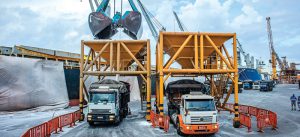Bloomberg
A glut of fertilisers at the biggest Brazilian ports signals that the price of the nutrients may have to drop further
before farmers start buying.
In Paranagua, private warehouses reached their maximum storage capacity of 3.5 million tons, according to Luiz Teixeira da Silva, Paranagua’s operations director. A terminal operated by VLI Logistics, one of the two at Santos port that store fertilisers, is also full.
Fertiliser prices soared to records after the war in Ukraine sparked fears of a shortage. Brazil imports nearly 85% of its fertilizer and Russia is the main origin. As supplies have normalised, prices have declined over the past weeks, but farmers still aren’t buying. They are waiting for further price cuts, according to Marina Cavalcante, an analyst at Bloomberg’s Green Markets.
“Farmers have expectation that prices will keep falling after declines last week and in previous one,†she said. “So they’ll wait for further decreases to buy.â€
Brazil is the world’s biggest shipper of several crops, including soybeans. Farmers can delay their purchases until the eve of the soybean seeding in September. But if they all wait too long, a last-minute rush could lead to inland transportation bottlenecks that may leave some of them empty-handed.
Brazil’s economy grew less than expected in the first quarter ahead of an expected downturn later this year, another setback to President Jair Bolsonaro as he readies his
re-election bid.
Official data showed gross domestic product expanded 1% in the January-March period from the previous quarter. The result fell short of the 1.2% median forecast in a Bloomberg survey. From a year prior, the economy gained 1.7%.
In recent months, Brazil has seen a string of better-than-expected indicators such as retail and employment.
, prompting many economists to raise their year-end GDP projections. Policy makers say the data is evidence the trend will carry.
The first quarter was likely a high-water mark for growth this year before what’s expected to be a bruising race between Bolsonaro and Luiz Inacio Lula da Silva. Expanded access to vaccines against Covid-19 and government aid to the poor have ensured demand. Still, double-digit inflation and borrowing costs are marring the outlook for Latin America’s largest economy.
The beginning of the year was marked by the omicron wave of the coronavirus that crimped business, but services still grew 1% as lingering health restrictions ended. The agricultural sector shrank 0.9% and investment plunged by 3.5%, the statistics agency said.
In recent months, Brazil has seen a string of better-than-expected indicators such as retail and employment, prompting many economists to raise their year-end GDP projections. Policy makers say the data is evidence the trend will carry.
“Brazil is one of the only cases where growth forecasts increased for 2022,†central bank President Roberto Campos Neto told lawmakers earlier this week.
Analysts caution, though, that the population is quickly losing its purchasing power. The quarter’s main drivers, services and family consumption, “are precisely the growth engines that will suffer the most from double-digit inflation and very tight domestic financial conditions,†said Alberto Ramos, chief Latin America economist at Goldman Sachs & Co LLC.
Just four months before elections, Bolsonaro is under mounting pressure to ease the soaring cost of living. Recent polls show that he is trailing Lula by 10 percentage points or more, and that he is widely blamed for the spiking cost of gasoline — a key voter concern.
 The Gulf Time Newspaper One of the finest business newspapers in the UAE brought to you by our professional writers and editors.
The Gulf Time Newspaper One of the finest business newspapers in the UAE brought to you by our professional writers and editors.
